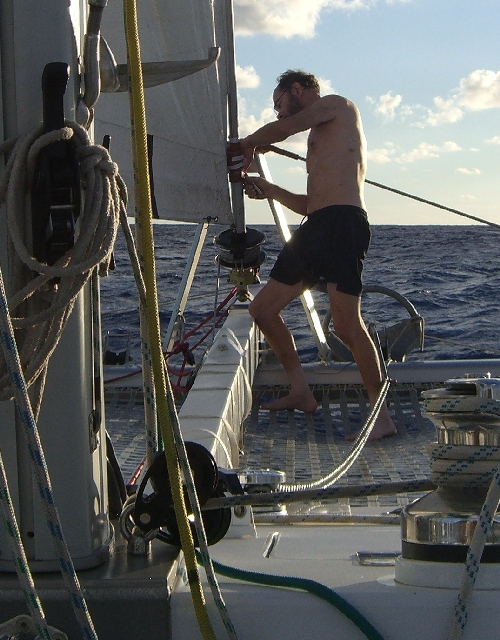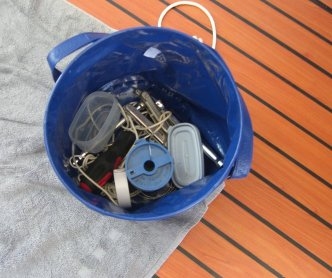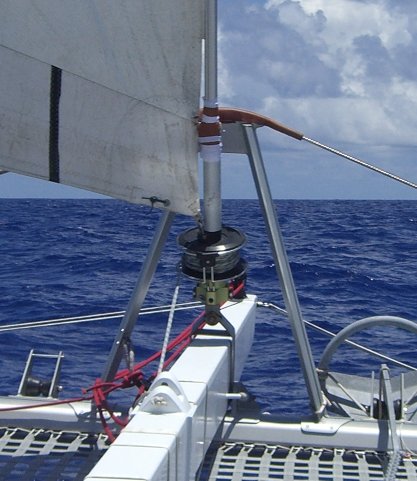Current Time: 1:24AM, Wednesday morning
Current Position: North 25 degrees, 03 minutes West 59 degrees, 06 minutes
Hi, Everyone.
So sorry for the silence. The sat phone charges were being put on a credit card that has a fairly low minimum, so even though we paid it off before we left, and because the charges were so high, well, you can guess the rest. I did the update last night, went to send it, and got “Invalid Account” on the phone’s display.
My brother, Chris, wiz that he is, and unbeknownst to us, figured out what was going on and had them reinstate the service. Meanwhile, back at the boat, Philip was trying to get the Pactor Modem to work – but it’s tough to get a signal where we are at the moment geographically, and he hadn’t succeeded by the time I tried the phone again, this afternoon. I realized I had service, and called the sat phone company (and Chris) and moved the new charges to another card. By the way, the sat phone company is All Road Communications in San Diego (http://www.allroadsat.com). They are wonderful people, always available, and if you ever need a sat phone, I’d highly recommend them.
Anyway, we’re back, we’re fine, and below is the update that I would have sent out last night.
Right now it’s a very bright night. The winds eased earlier today, so we increased the size of the mainsail. Only the first reef is engaged right now. Outside of worrying about everyone worrying about us, we’re doing great. It’s going to be so strange not to be sailing all day, when we get home!
We’re getting very close to Bermuda, and don’t know yet whether we will stop or not.
Thanks for your patience.
kz
———————————
Current Time: 1:49 AM, sort of
Current Position: North 22 degrees, 40 minutes West 57 degrees, 30 minutes
Hi, Everyone.
Well, the Captain pulled it off. It wasn’t easy, and he’s a bit bruised up, but he did it. The jib is rolling up beautifully now and we are able to get it into good trim while underway.
I managed to snap a picture in the midst of keeping the boat going at the right speed and in the right direction relative to the wind. I did it for the Captain and for you, Dear Readers. 🙂
Here’s is the same shot of the captain jury rigging the roller furler, one to give you the big picture, and one cropped, “up close.” There are a lot of things the picture doesn’t show. I’ll let the Captain tell you – as dictated to me this afternoon. But first, for you sailor wanna-be’s, a couple of notes.
– A hose clamp, if you’ve never seen one, is a thin metal strip, that goes around something like a rubber hose to create a tight seal between the end of the hose and whatever it’s been pushed on to. Hose clamps come in all sizes, because hoses come in all sizes. The thin metal strip is mostly solid metal, but one end has groves in it and the other end has a screw. The screw’s threads go into the groves – so you can tighten the clamp around the hose. There are many hose clamps on a boat. It’s one of those things that you need to keep an eye on. In this case, Philip was using three large hose clamps – big enough to go around the aluminum tube (extrusion) at the base of the jib.
– In this picture you can see the “spool” part of the roller furler that rolls up the luff (forward edge) of the sail. The line in the spool goes aft to a winch. You roll the sail up by winding up the roller furler line on the winch, while easing the jib sheet (the line at the clew of the jib – the aft, bottom corner of the sail) at the same time. That makes the sail smaller. You make the sail larger by easing the roller furler line while cranking in the jib sheet on the winch. If you don’t know what a winch is, look at the bottom right-hand corner of the picture. That winch, in fact, is the one we used to hoist the sail back up when he was finished. It’s got the jib halyard on it – the line that pulls the sail up to the top of the mast.
– Philip will tell you the other things the picture doesn’t show, but one thing you can’t see is a vinyl bucket, which he has tied to the seagull striker wire – that big diagonal wire just in front of his torso. His body is hiding the bucket from us in this picture, so it’s right near his right elbow. That’s where all his tools were. Most of the tools had a lanyard (a piece of string) tied to them, so he could put the string around his wrist as he was working, and if the tool fell out off his hand, it wouldn’t fall into the water. Such a thorough guy.
The Captain [with notes from the Admiral]:
Here’s what the picture doesn’t show. It doesn’t show the planning and organization before hand. It doesn’t show the motion of the sail, which was flailing in the wind, back and forth, violently, shaking what I was working on, so badly that I couldn’t use a screwdriver to tighten the hose clamps which retained the pins that I’d made from the bolts, which substituted for the set screws that fell out. The whole assembly was jumping around so much from the flailing of the sail, you couldn’t get the screwdriver into the slot of the screw for the hose clamp, and turn it. Thanks to the planning and organization beforehand, I had a socket wrench that fit the hose clamps that you could successfully get onto the tightening screws and tighten them.
It also looks like the boat is just sitting there. Not true. It’s like a violent, erratic freight elevator out there, being operated by a madman. One second, you’re almost weightlessly plunging downwards toward the water, usually suddenly reversing when your feet are six inches above the surface, then suddenly flying upwards, while you’re wondering how long it’s going to continue, followed by another drop. This is not a regular up and down thing, because the waves are not all that regular. Sometimes you go up a little, sometimes you go up forever. Sometimes a wave hits one of the bows, and throws a whole lot of spray in the air, which the wind blows all over what you’re doing – and your tools.
The final assembly consisted of the three pins that I made, inserted into the three set screw holes. Each pin was wrapped in two turns of electrical tape, which was as much as would fit into the hole. Then electrical tape around the extrusion, to hold the pins temporarily in place and protecting the extrusion from the hose clamp, which came next. Then a piece of leather to protect the sail from the hose clamps, held on with wraps of safety (bailing) wire, then the bailing wire was covered up with electrical tape. I had chewing gum in my mouth, but I didn’t need to use it. [Bailing wire and chewing gum, get it? The Captain has to chew gum because the cancer treatments removed about 90% of his saliva-generating ability. It did strike me, while in the cockpit, how casual he looked up there, doing that kind of intense work, while chewing gum.]
I taped my one broken toe to the adjacent two. Now I think one of those is broken or badly bruised – it’s discolored in two places. Something damaged the bottom of my foot. Hands are sore from wrestling the luff of the sail back into the tiny groove that holds it in place, while it was flogging around. That’s an operation normally done on a calm day in a marina.
Faint-hearted sailors should stick with lakes and bays. 🙂
pz
———–
Back to the Admiral.
Well, I was one proud crewmember today. Good operation, all around. The conditions were not perfect – the wind was blowing in the high teens, I think, thanks to some clouds we were sailing under. Usually the mornings are calmer. And the waves were fairly steep – about 20 – 25 feet, I think, somewhat irregular, and close together. But the Captain was prepared and determined, so he jumped out of the berth and it was show time.
My job was to be ready to help with anything he needed, such as hoisting/lowering the jib or easing the roller furler from the cockpit, and to keep the autopilot and the one engine – the starboard (right) hull engine – giving us just enough power to maintain steerage, but not so much that we started pushing through the waves. Too much spray when we do that, and too much motion, for good working conditions. I found the sweet spot was about 2 knots.
The waves and the sail flailing in the wind all had an effect on the speed of the boat, so I had to keep dashing into the pilothouse – we left the engine controls on there, rather than the cockpit, so I could see the RPMs on the engine – to adjust the speed of the engine and the angle that the autopilot was steering to.
The sail, although it was “flailing,” was doing so on purpose (we didn’t want any load on it), and under control. I found that the angle to the wind that he needed – to keep it at just the right angle while he was working – was about 58 degrees. The autopilot was steering 10 – 15 degrees to the right and left of that, however, until I increased the “gain” on the autopilot and it steered more accurately. Still, it was working hard – the waves push the bows around quite a bit in that kind of situation, especially when you’re only going 2 knots.
The final result of the operation is the usual elegant, belt-and-suspenders job that Philip tends to do. You can see it here, the leather piece with the white tape around it, on the jib extrusion. You can also see the “spool” clearly here. The black vertical line in the sail is the “first reef” – we wind up the sail to this line first, when we are “shortening” the jib.
Now it’s the wee hours, I’m on watch, Philip is sleeping. The moon is fairly bright, and we’ve had some lovely little moon showers tonight. Not enough to drench the boat and clear it of all Sahara Dust, but welcome in any case. Rain here, in the northern hemisphere, has been very slight and quite gentle, not at all like the battering ram squalls south of the equator.
The jib is rolled all the way out and we’re making 8 – 10 knots, still on the same starboard tack. Matthew tells us that the wind, in about 4 days, will move clockwise to a more southerly direction, as we make our way toward Bermuda.
We had the last two good eggs today. Well, the Captain did. I thought he deserved a hearty eggs, bacon, and sticky bun breakfast. We also decided it was time to bake – it was cooler today than it has been, and it was time to create another type of snack for our watches. Unfortunately, all the muffin mixes call for an egg. I decided to substitute. Now, I should tell you that Matthew and I, while discussing cooking with the refrigerator guy who was working on the boat one day in Cape Town, both said, almost in unison, that “cooking is art, baking is science.” The cook in me is delighted to say that I managed to violate the rules of science today and get away with it.
One thing I should have done that I didn’t think of was to get some egg substitutes for the boat, for baking and breakfasts. But, I didn’t, so I had to get creative.
All you foodies are really going to think the Admiral is nuts…my egg substitute was a mixture of cooked and mashed up gem squash (which is sort of a cross between zucchini and pumpkin), some condensed milk, and some baking powder. I figured the eggs added some moisture and some rising power, and some creaminess, so that was the rationale for what I used. Of course, I had to make do with what I have on hand.
I could have gotten away with more of this mixture, it turns out; the muffins didn’t rise as much as I would like. But, they are quite moist, partly because I added tiny cut-up bits of pecans, soaked and unsoaked raisins, and cut-up canned apple pieces, which aren’t syrupy like they are in the States, but are just plain old soft apple pieces.
This was the first time I’ve used the oven for baking, and I was very happy with the result. It got up to temperature quickly and stayed there. The silicone muffin “tin” that we bought in Cape Town didn’t melt (first time I’ve used one – it still amazes me that they can take the heat), and, even though the “tin” “just fits” into the oven, the muffins were cooked evenly throughout. I am encouraged.
With all the spray flying around, you can’t open the overhead hatches, so the galley can get pretty toasty. I will be glad when we do more day cruising/anchoring overnight. We can open the hatches while at anchor and get some nice ventilation going. But even so, it’s still a joy to cook in this boat’s galley.
Turns out these emails are getting passed on quite a bit; I guess we all have a sailor or two in our lives…one wonderful note came back today from a woman named Jackie, who lives in South Africa. She says:
“I don’t know you, probably will never meet you, but the power of the internet is that I am living your journey with you! Your mails are being passed on..via via via! I can’t wait to receive the updates, sometimes I read them and think – Oh my God – I could never do what you are doing, and other times I just want to sell everything up, buy a boat, and do what you are doing!”
I will reply to her tonight, and I imagine we will continue to correspond. She sounds like a lovely person. Jackie and my friend Nancy mentioned the recent French airplane crash in the Atlantic. I am so sorry to hear about it. I should say that no, we have not seen any debris. You cannot imagine how big this ocean is. We have been sailing, 24/7, since April 20, and have only seen a few ships, and only saw land when we carefully picked our way to a tiny island (St Helena) in the middle of all this water. Otherwise, it has been all water, all the time. It is just literally beyond our imaginations how big this water is, and how much of the planet is covered by all this water.
Must get other writing done tonight, got a good night of sleep and am lucid enough to turn out some decent copy.
We are slowly getting our clocks set to the right time; we missed a couple of time zone changes.
Thanks for reading, and thanks for your notes and good wishes. You warm our hearts.
Much love.
Philip and Kristin




